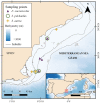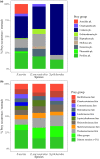Trophic niche overlap between round sardinella (Sardinella aurita) and sympatric pelagic fish species in the Western Mediterranean
- PMID: 34824816
- PMCID: PMC8601905
- DOI: 10.1002/ece3.8293
Trophic niche overlap between round sardinella (Sardinella aurita) and sympatric pelagic fish species in the Western Mediterranean
Abstract
The northward expansion of round sardinella (Sardinella aurita) in the Mediterranean Sea, together with declines and fluctuations in biomass and landings of European sardine (Sardina pilchardus) and anchovy (Engraulis encrasicolus) observed in recent decades, may suggest potential inter-specific competition in the pelagic domain. The coexistence of sympatric zooplanktivorous fish species might therefore be exposed in part to trophic niche overlap and competition for food. Combining visual diet characterization under the microscope with DNA metabarcoding from stomach contents of fish collected in spring results show that predation on relatively large krill is equally important for sardinella than for the other two niche overlapping species. Furthermore, an important overlap is found in their isotopic niche, especially with anchovy, using nitrogen (δ15N) and carbon (δ13C) stable isotopes in muscle tissue. In fact, the three fish species are able to feed effectively in the whole prey size spectrum available during the sampled season, from the smallest diatoms and copepods to the larger prey (i.e., decapods and euphausiids), including fish larvae. Moreover, effective predation upon other large prey like siphonophores, which is observed only when multi-proxy analyses in stomach contents are applied, might also be relevant in the diet of sardinella. The overlapping diet composition in spring, together with the effective use of food resource by sardinella, can be of special interest in potential future scenarios with warmer water temperature leading to lower zooplankton and/or higher jellyfish availability, where sardinella may take advantage over other species due to its feeding plasticity.
Keywords: diet dissimilarity; multi‐proxy diet analysis; prey preference; small pelagic fish; trophic interactions; trophic niche width.
© 2021 The Authors. Ecology and Evolution published by John Wiley & Sons Ltd.
Conflict of interest statement
The authors declare that the research was conducted in absence of any commercial or financial relationship that could be construed as potential conflict of interest.
Figures







References
-
- Albo‐Puigserver, M. , Borme, D. , Coll, M. , Tirelli, V. , Palomera, I. , & Navarro, J. (2019). Trophic ecology of range‐expanding round sardinella and resident sympatric species in the NW Mediterranean. Marine Ecology Progress Series, 620, 139–154. 10.3354/meps12962 - DOI
-
- Albo‐Puigserver, M. , Navarro, J. , Coll, M. , Layman, C. A. , & Palomera, I. (2016). Trophic structure of pelagic species in the northwestern Mediterranean Sea. Journal of Sea Research, 117, 27–35.
-
- Amundsen, P. , Gabler, H. M. , & Staldvik, F. J. (1996). A new approach to graphical analysis of feeding strategy from stomach contents data — modification of the Costello (1990) method. Journal of Fish Biology, 48, 607–614. 10.1111/j.1095-8649.1996.tb01455.x/abstract - DOI
-
- Bacha, M. , & Amara, R. (2009). Spatial, temporal and ontogenetic variation in diet of anchovy (Engraulis encrasicolus) on the Algerian coast (SW Mediterranean). Estuarine, Coastal and Shelf Science, 85, 257–264.
LinkOut - more resources
Full Text Sources

